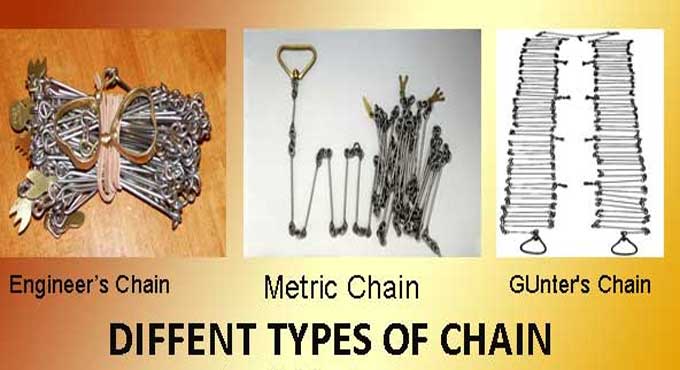
Chain Types in Surveying and their Merits and Demerits in Construction

Chains are flexible because of these rings. Measuring units are required in every aspect of life. Similarly, calculations and measurements are valuable in construction, surveying, or other fields. Any entity can be measured using various instruments, just as with units. Chains are an instrument used in the measurement.
Measurement chains have 100 galvanized mild steel wire links of 4mm diameter. Work is carried out precisely and accurately using measurements. Measurements are used in every corner of the house, from the kitchen to the office. In addition to meters, centimeters, feet, inches, acres, yards, and more, there are various measurements.
Define Chain Surveying
A chain or tape is used to measure each side of the triangle in chain surveying. Each triangle is divided into small triangles in certain areas. To measure the area of land, different types of chains are used in surveying.
Besides measuring length and width only, chain surveying does not take angular measurements, making it an ideal method for small, less obstructed areas. The term chain triangulation is also used to describe chain surveying.
Chain Types
Revenue Chain
There are 16 links in this Revenue chain, each with a height of 2.06 feet, which is commonly used in cadastral surveys. It is a standard size of 33 feet, and each link is 2 feet long.
Surveyor Chain
It consists of 100 links that measure .66 feet each so that the chain is 66 feet long. Surveyors' chains are also known as Gunter's chains.
Steel Band Chain
Steel Band chain consists of a broad strip of blue steel with uniform dimensions of 12mm to 16mm and .3mm to .6mm thickness. When continuous use is experienced, the links bend and the length of the chain shortens due to the constant bending of the chain.
Metric Chain
There are many types of chains used in surveying, but the metric chain is widely used among them. It is widely used in surveying and is available in standard lengths such as 5 meters, 10 meters, 20 meters, and 30 meters.
While in surveying, metric chains generally have a length of 20m, and some interval tallies are fixed to simplify measuring. In the case of chain lengths from 5 meters to 10 meters, tallies are fixed every 1 meter, and in the case of chain lengths from 20 meters to 30 meters, the tallies are fixed every 5 meters.
Every tally in this chain bears the letter M, and on the brass handle of the chain the length of the chain is inscribed.
Engineer?s Chain
The Engineer's Chain is 100 feet long and contains 100 links, each measuring 1 foot; also, the reading is taken in decimal and feet. Engineer's Chain includes a brass tag every 10 links for a distance of 10 feet.
Chain Parts Applications in Surveying
Measurement chains include many small components used for handling and reading measurements.
Providing a brass handle with a swivel joint at the ends allows the chain to be rolled or unrolled easily without twisting. An easy to read circular tray is located at the center of the chain.
A tally of one tooth is provided at every 10th link, two teeth at every 20th link, and so forth until the 40th link. A convenient way to read measurements is provided by this method.
Merits of Chain Surveying
There are only a few people required to conduct a chain survey. Chain survey teams usually have three members: a leader, a follower, and a booker.
An exercise in surveying is traditionally conducted with a chain survey since it is the simplest and most common type of survey. Chain surveys are conducted using simple equipment. A chain survey can easily be replaced with a new piece of equipment. Measurement tapes can be used in place of measuring rods.
People who are afraid of mathematics will appreciate this method because it does not require complicated mathematical calculations.
Demerits of Chain Surveying
Large areas and built up areas cannot be surveyed with a simple chain survey.
Simple chain surveys can be subject to errors of accumulation due to chain problems. Data may be inaccurate if the chain linkage does not stretch properly.
To learn more, watch the following video tutorial.
Video Source: Learn Civil Tech & Tricks
Likewise, clogs in the chain may cause reading errors. The process is time consuming and may not be feasible in areas with steep slopes or waterlogged conditions. The majority of chain surveys are conducted in dry, gently sloped areas.
An area that is too wet makes surveying more challenging. Whenever there are raised points between areas to be surveyed, chain surveys become more complicated.


